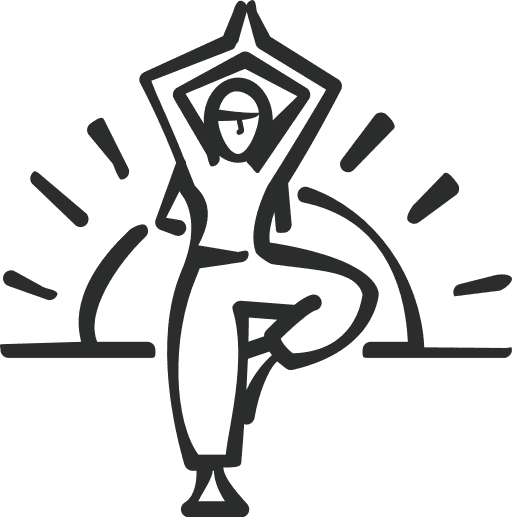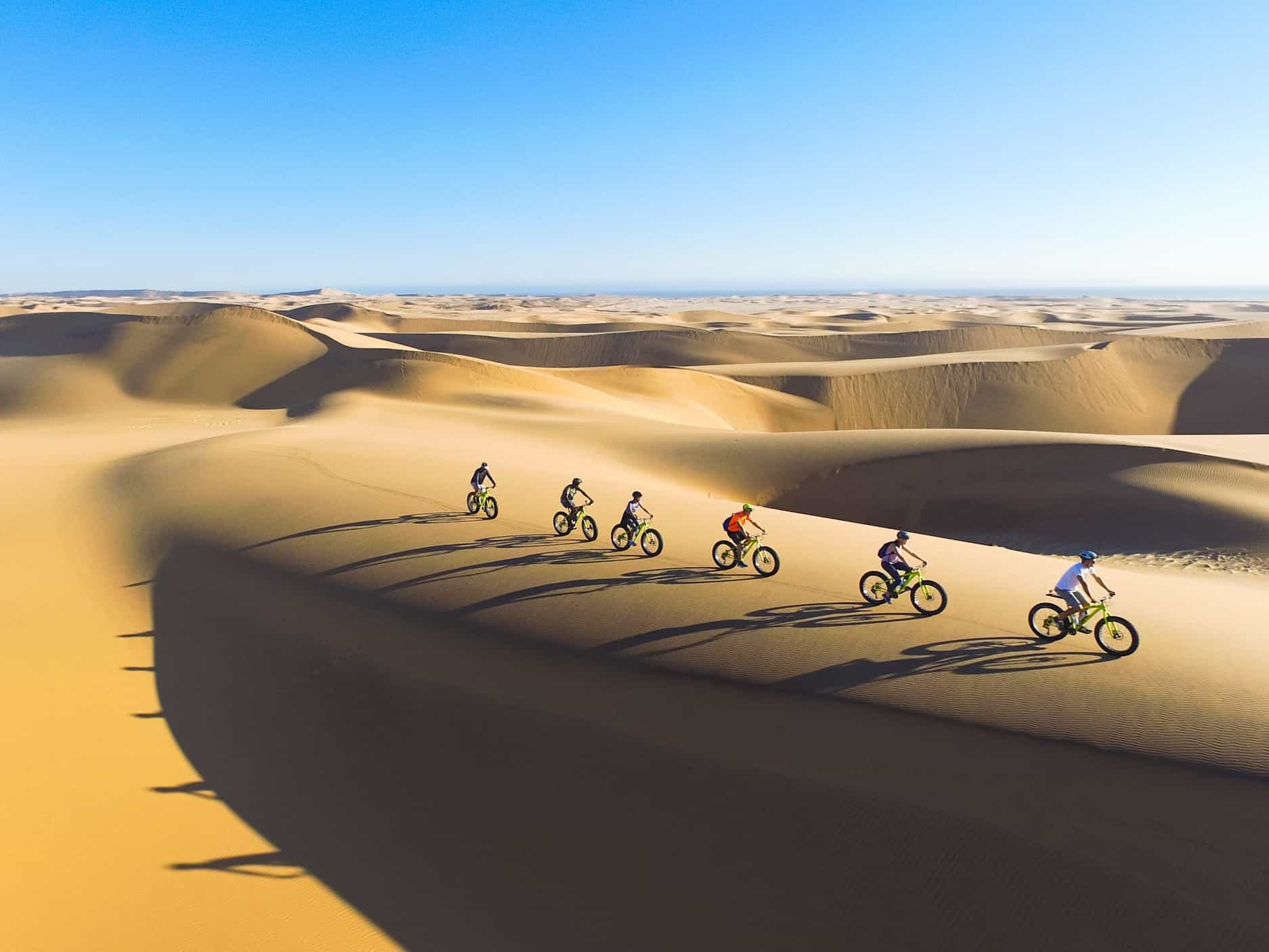
Cycle, Safari and Stargaze in Namibia: The 2026 Edition
Ride through Namibia’s epic dunes, spot wildlife in Etosha, and sleep beneath starry desert skies
What's Included?
Activities & Certified Guides
All itinerary activities with expert, local, English-speaking guides and a bike mechanicHotel & Camping
3 nights in hotels, 6 nights desert campingMeals
All breakfasts, 3 lunches, 3 dinnersTransfers & Support Vehicle
Group airport transfers and everything in between, including a support vehicle to carry your gear or hop into if your legs need a restGear
Silverback & GT 29ers hardtail mountain bikes; plus tents and sleeping pads for campingSmall Like-minded Groups
Solo-friendly by design, join our small n’ sociable groups of up to 10 like-minded, active and outdoorsy people…
…
What's it like?






























Explore Otjiwa Reserve and Etosha National Park, spot wildlife on game drives, and enjoy an awe-inspiring evening at a waterhole under the stars
Hop on a fat bike to pedal up and down the Namib Desert’s towering dunes, with the Atlantic Ocean on one side and vast desert on the other
Catch the sunrise over the massive sand dunes of Sossusvlei, one of the world’s most ancient desert landscapes
Want to travel this year? Head over to our 2025 edition of this adventure
Key Information
Day 1
Welcome to Namibia!
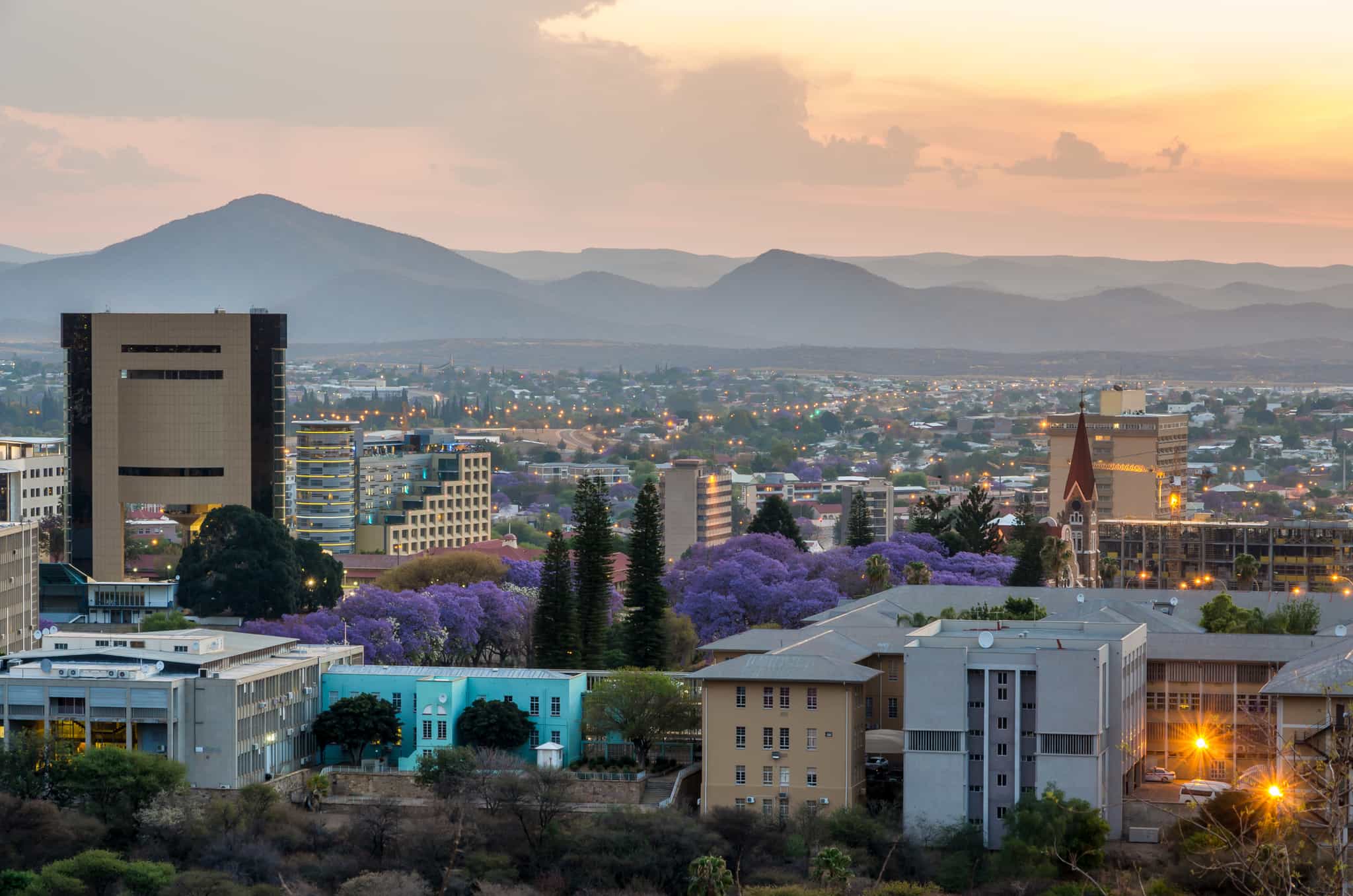
Touch down in Windhoek and head to your hotel. If you’ve got time and energy, you can explore the surrounding area; if you'd rather relax, the hotel has its own pool – so just kick back! Join your group and guide later in the day for dinner, taking the chance to sample some delicious Namibian cuisine as you get to know your fellow adventurers.
Day 2
Hit the road for a sunset bike safari
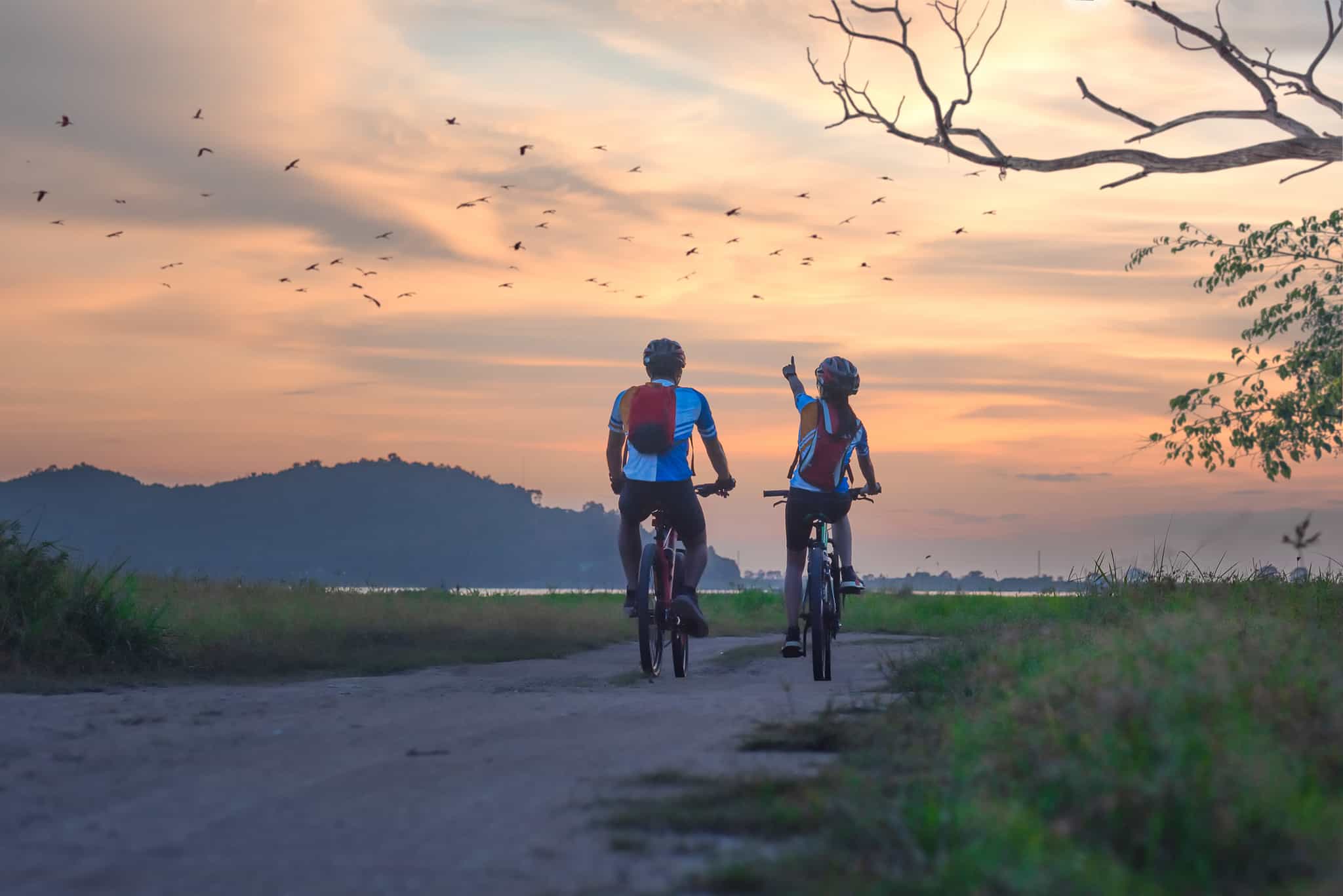
Driving
Cycling
Today, the adventure begins. Hit the road north to Otjiwa, one of Namibia’s oldest private reserves and home to a rich array of wildlife – including the rare and elusive white rhino. Keep your eyes peeled during the journey; this is safari country. This afternoon, hop on your bike for your first ride, pedaling across jeep tracks and wildlife trails as the bush stirs to life for the evening (the perfect introduction to riding in the wild). Enjoy a satisfying dinner back at the bush camp, surrounded by the sounds of the African night.
Day 3
Etosha National Park
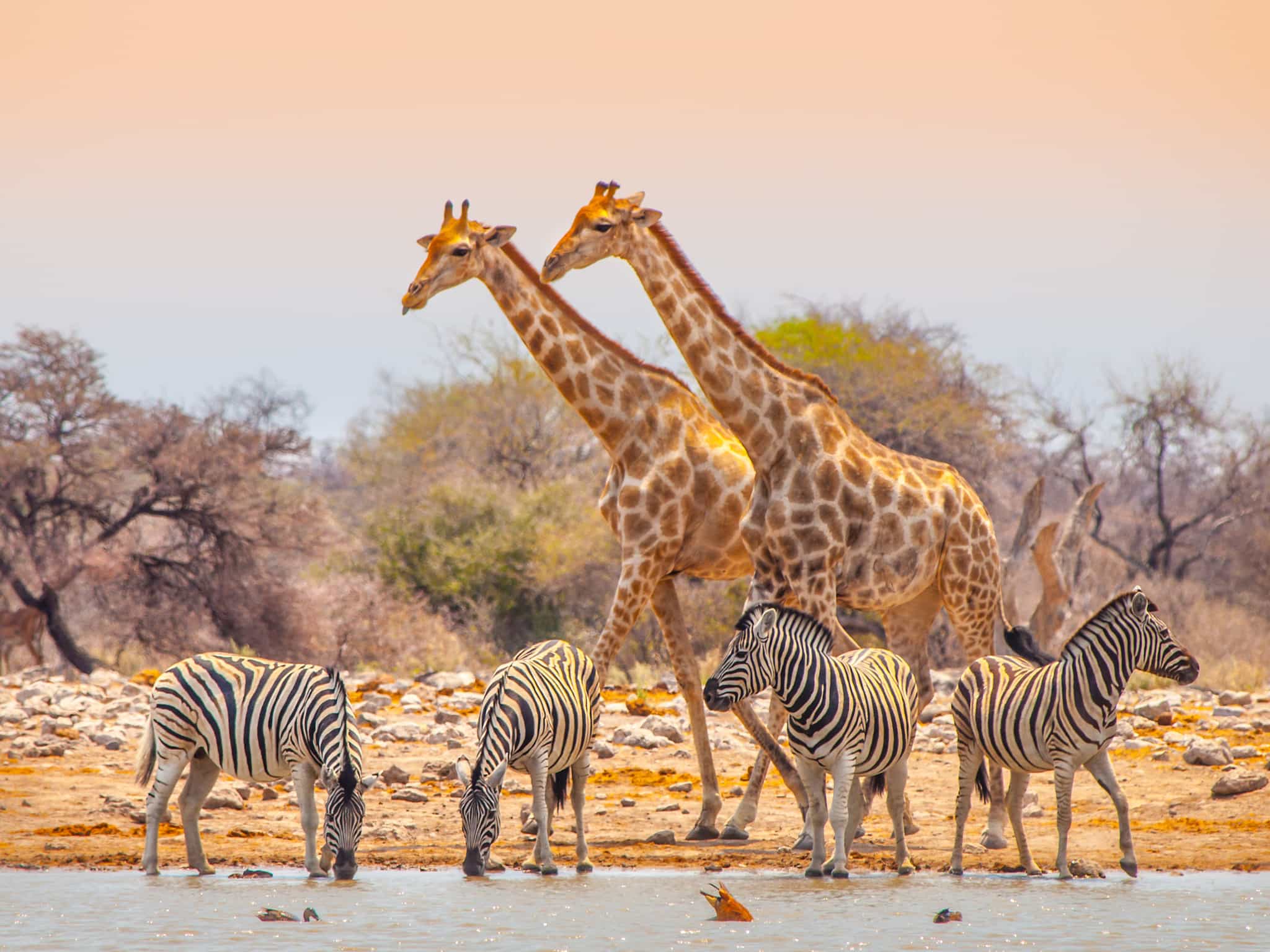
Cycling
Driving
Early risers can enjoy a short morning ride from the camp before heading to Etosha National Park, one of the greatest national parks in Africa and a hot spot for lions and rhinos. After a quick stop for pastries at Outjo Bakery, you’ll arrive at Etosha and head out on a game drive – eyes peeled for lions, elephants, and giraffes on the move. Etosha is full of waterholes and these are dotted all over this vast landscape. These waterholes are where the animals congregate, particularly in the dry season (from April to October), when water is scarce elsewhere. This evening, you'll have a chance to sit by the local watering hole and watch the animals come down to drink. Staying up late at a waterhole in Etosha, soaking up the calm silence of the African bush, watching the shooting stars and waiting with bated breath for the next visitor is one of the true highlights of this trip.
Day 4
Spitzkoppe skies
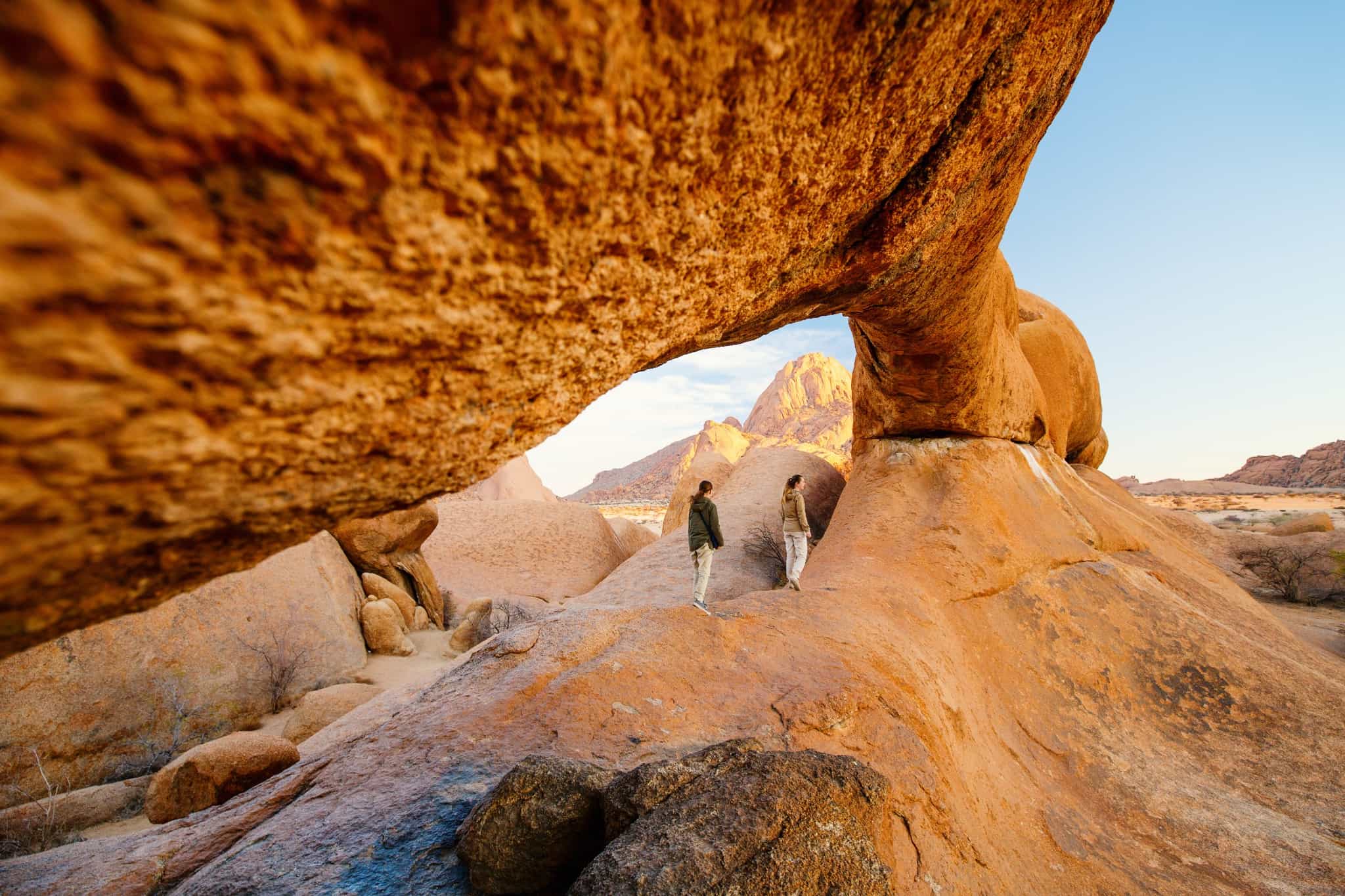
Driving
Start the day with a short morning game drive – one last chance to spot some wildlife before leaving Etosha behind. Set off toward Spitzkoppe, the iconic mountain known as 'Namibia’s Matterhorn', stopping for a picnic lunch en route. You'll see the iconic shapes of the massif from the road as you approach, and as you enter the huge campground you'll see why our adventurers say this is the best camp spot in all of Namibia. Settle into camp, then set off for a short sunset walk to the Spitzkoppe Arch. This surreal, beautiful landscape of massive granite boulders rising out of the desert is a great place to stretch your legs and take it all in. After your sunset walk, get comfy at your simple camp and enjoy a peaceful night under a star-filled sky.
Day 5
From moon landscapes to the Atlantic

Driving
Cycling
This morning, settle in for a two-hour transfer to the start point of today's ride, before getting on your bike to pedal along hard-packed gravel roads through open desert to the lush oasis of Goanikontes. Refuel with lunch and coffee, then tackle the next stage through the Moon Landscape – an ancient, craggy terrain shaped by millennia of erosion. The day finishes with a drive to the coastal town of Swakopmund, a popular town with a German flavor, where the Atlantic meets the dunes. You can explore the town and grab a cold beer overlooking the Atlantic Ocean.
Day 6
Fat biking the dunes

Cycling
Get ready for one of Namibia’s most unique adventures – a fat bike ride through the Namib Desert dunes. The oversized tires make light work of the sand, and the landscapes are jaw-dropping. If tides are favorable, you can cruise along the Atlantic shoreline before heading inland across the towering dunes. This is all about fun – the dunes are huge and tightly packed, so propelling yourself down them on a fat bike is an experience you certainly won’t forget. The afternoon is yours to relax and explore Swakopmund’s quirky cafes and seaside charm.
Day 7
Into the desert's heart

Driving
Cycling
Leave the coast behind and drive southeast toward the Kuiseb Canyon and Gaub Pass. This region marks your transition from highlands to desert plains. Expect rolling gravel roads and wide-open views. Cycling today depends on the weather—heat, wind, and road conditions all come into play. Your guide will pick the perfect starting point, and the ride will usually be about 25–30 miles. Pedal through vast open spaces, stopping for a picnic lunch and spotting ostrich, warthog, and oryx just off the road. Reach the quirky outpost of Solitaire, which feels like something out of a forgotten Western – a scattering of weathered buildings, rusted old cars, and a famous bakery known for its unexpectedly legendary apple pie.
Day 8
Queen Stage to Sesriem
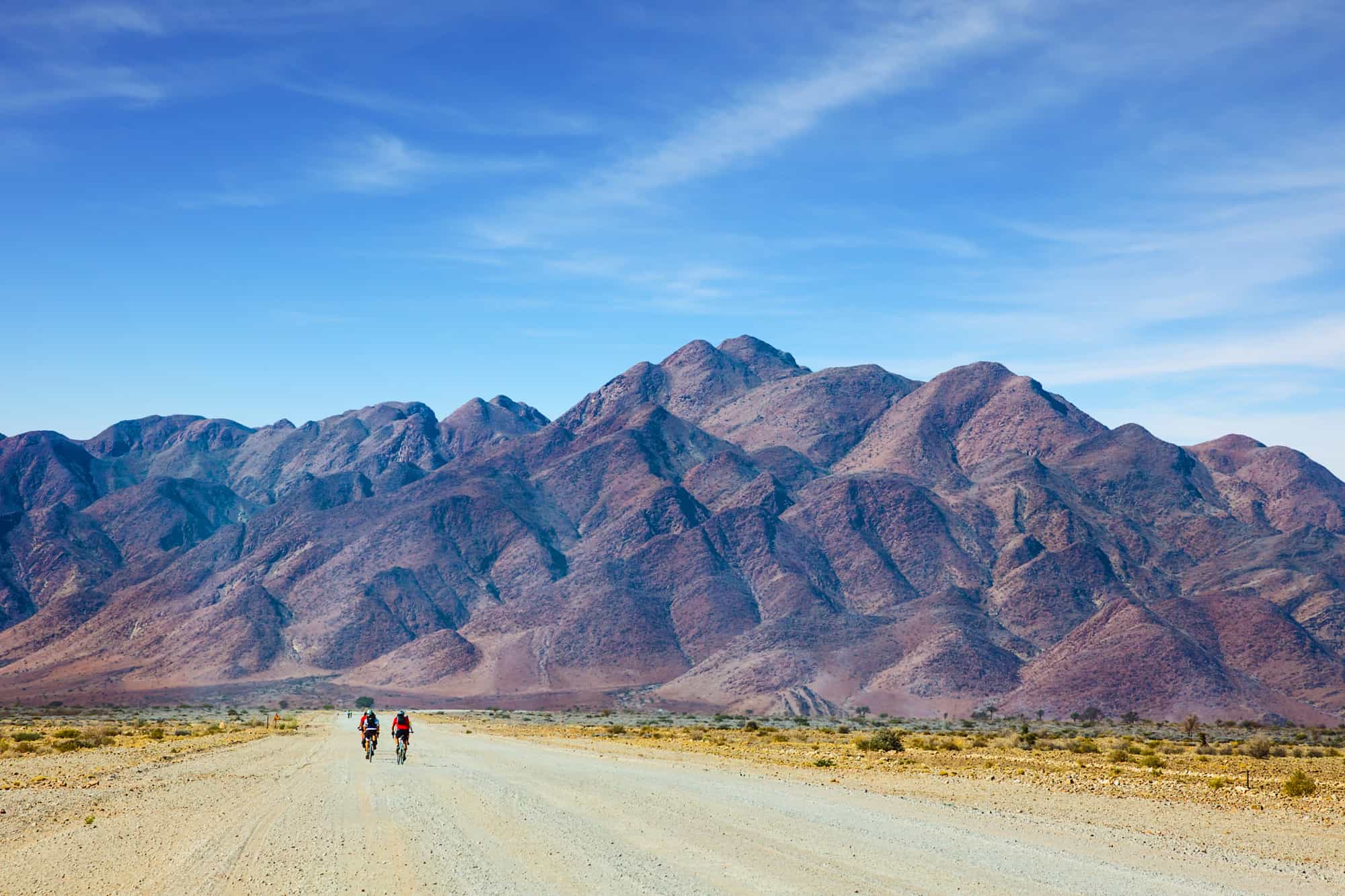
Cycling
Driving
Today’s ride is the big one – the Queen Stage! Starting from Solitaire camp, you’ll head deeper into the desert on a mix of gravel and asphalt roads, with the full route covering over 50 miles all the way to Sesriem, the gateway to the Namib dunes. If you're feeling strong, go for the full distance. Otherwise, it’s the norm to cycle around 30 miles, before jumping in the support vehicle for the final stretch. No matter how far you ride, it’s a rewarding day of wide-open desert views and smooth, steady pedaling. The camp at Sesriem is surrounded by enormous red sand dunes and has an inviting pool to cool off in.
Day 9
Sossusvlei dunes at sunrise
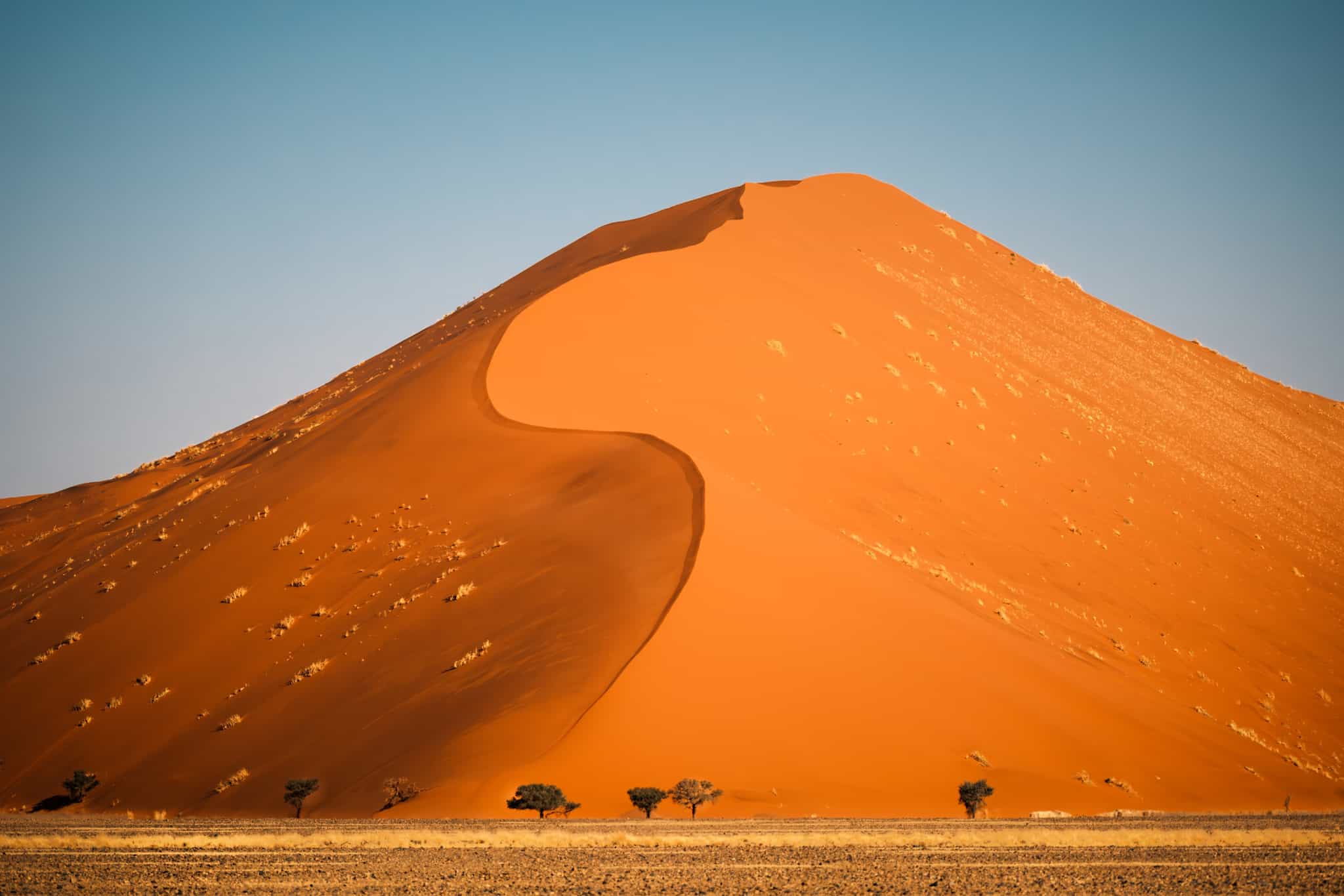
Cycling
Driving
Wake before sunrise and head into the heart of Namib-Naukluft National Park, home to the oldest desert on Earth. Climb Dune 40, the lesser-known sibling of Dune 45, meaning fewer crowds and more space to soak up the sunrise as it spills golden light across the vast sands. Walk, run or roll down the giant wall of sand, then tuck into breakfast and coffee at the foot of the dunes. Next, hop on your bike and pedal through one of the planet’s most surreal landscapes. You can choose to cycle toward Sossusvlei, then take a 4x4 into Deadvlei – a cracked clay pan scattered with fossilized trees (this costs 200 Namibian Dollars per person, around $11, and is payable locally). Alternatively, cycle the whole way back along a smooth road flanked by towering dunes. All day, it’ll feel like you’re riding through a film set (Mad Max: Fury Road was filmed around here). After lunch at camp, transfer to Stofpad for a dip in the pool and your final night under the stars.
Day 10
Back to Windhoek

Driving
Kick back in the van and take in the dramatic landscape for one last time as you drive back to Windhoek, arriving at the airport in time for evening flights home.
The Area
Logistics
Starts
Windhoek International Airport, Namibia (WDH)
10:00 on Day 1
Ends
Windhoek International Airport, Namibia (WDH)
18:00 on Day 10
Transfers
A group arrival and departure transfer is included if you arrive on Day 1 and depart on Day 10.
On Day 1, the included group airport transfer is at 10:00 AM, as there are several overnight flights arriving into Windhoek Airport in the morning. On Day 10, there is an included group transfer to drop you at the airport in Windhoek at 6:00 PM, for all flights departing after 8:00 PM. Please do not book a flight earlier than this, as the last day includes a few hours of driving, therefore an earlier private transfer is difficult to arrange.
If required, private transfers to the lodging in Windhoek can be booked for those arriving at earlier or later times for an additional cost, please see 'Optional Extras' for more details. Transfers from Windhoek Airport to your first hotel take approximately an hour. If you are flying home later than Day 10, an extra night's lodging and private airport transfer can be arranged for you (again, see Optional Extra for prices). Please request this with your host after booking.
Travel options
There are regular flights to Namibia from major airports across the US, Europe, and North America, with connections typically through hubs such as Frankfurt, Amsterdam, Doha, or Johannesburg.
Day 1
Breakfast
Lunch
Dinner
Day 2
Breakfast
Lunch
Dinner
Day 3
Breakfast
Lunch
Dinner
Day 4
Breakfast
Lunch
Dinner
Day 5 – Day 6
Breakfast
Lunch
Dinner
Day 7
Breakfast
Lunch
Dinner
Day 8 – Day 9
Breakfast
Lunch
Dinner
Day 10
Breakfast
Lunch
Dinner
What is the food like?
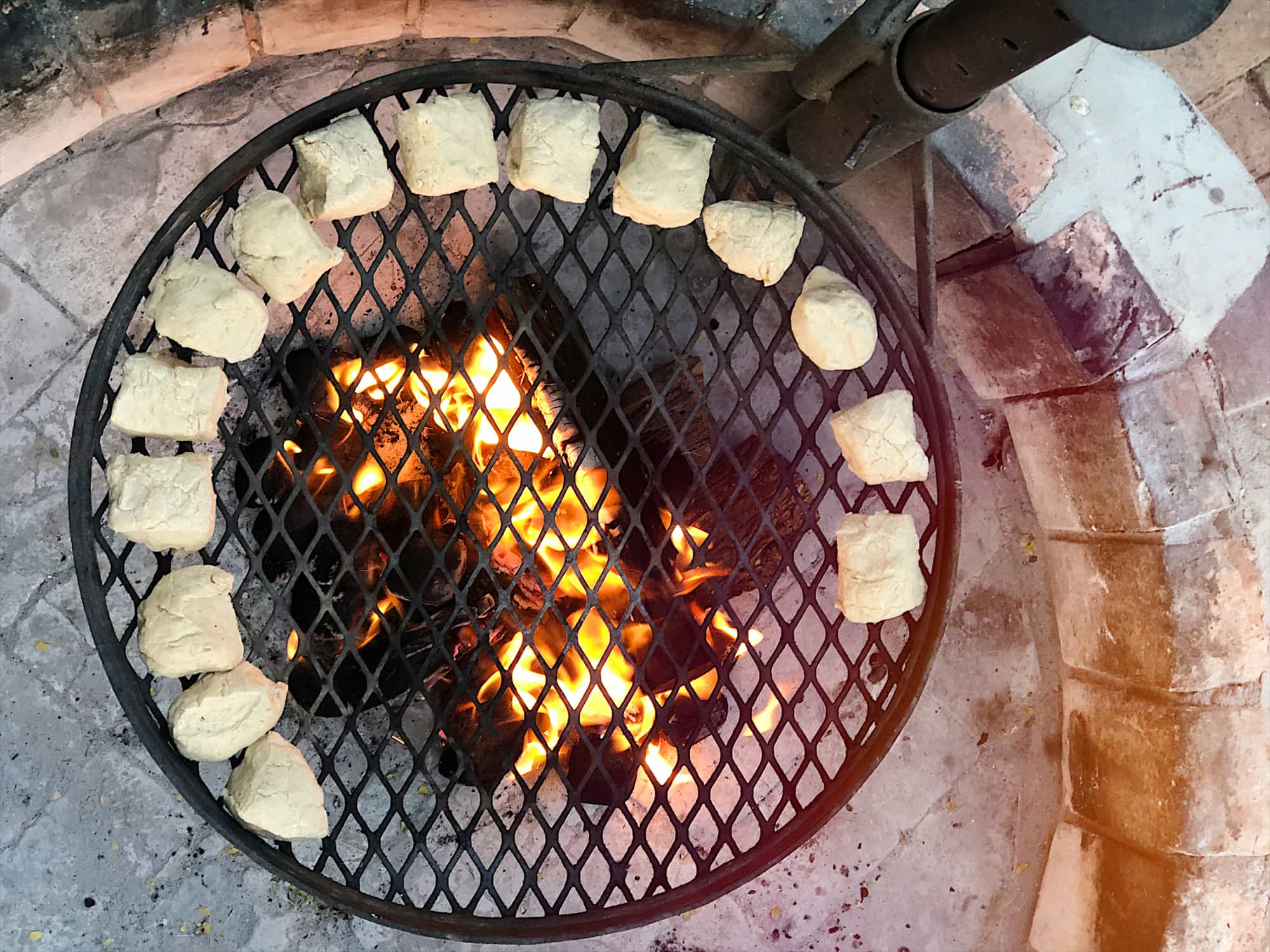
When staying at campgrounds, your guides will generally cook for you. These will be hearty meals cooked over an open fire – for dinner, expect BBQ food, potjie, and stir-fries with various sides. You will also stay at hotels and campgrounds where dinner is not included; here, meals will generally be taken at a restaurant on-site or close by where the group will eat together, so please budget $12-18 per dinner for these nights. Breakfasts will be continental-style and usually consist of cereals, coffee, yogurt, muesli, fresh fruit, or the occasional fried breakfast. The guides will appreciate your help with washing the dishes. Most lunches on the trip aren't included – you'll need to buy lunch from small grocery stores, cafes, and restaurants. Your guide will factor these supply runs into your day, or often you'll buy packed lunches from the campgrounds for the day ahead. Expect a good selection of sandwich ingredients like cheese and cold meats, plus pasta and salads. Budget around $6-10 for each lunch that isn't provided. Snacks are provided while cycling.
Vegetarians, vegans, and other dietary requirements and allergies can be catered for – please just let your host know on booking. Please note that vegan options are very limited in Namibia, so if you're a strict vegan we suggest packing some of your favorite snacks or protein bars for extra fuel.
What is the accommodation like?
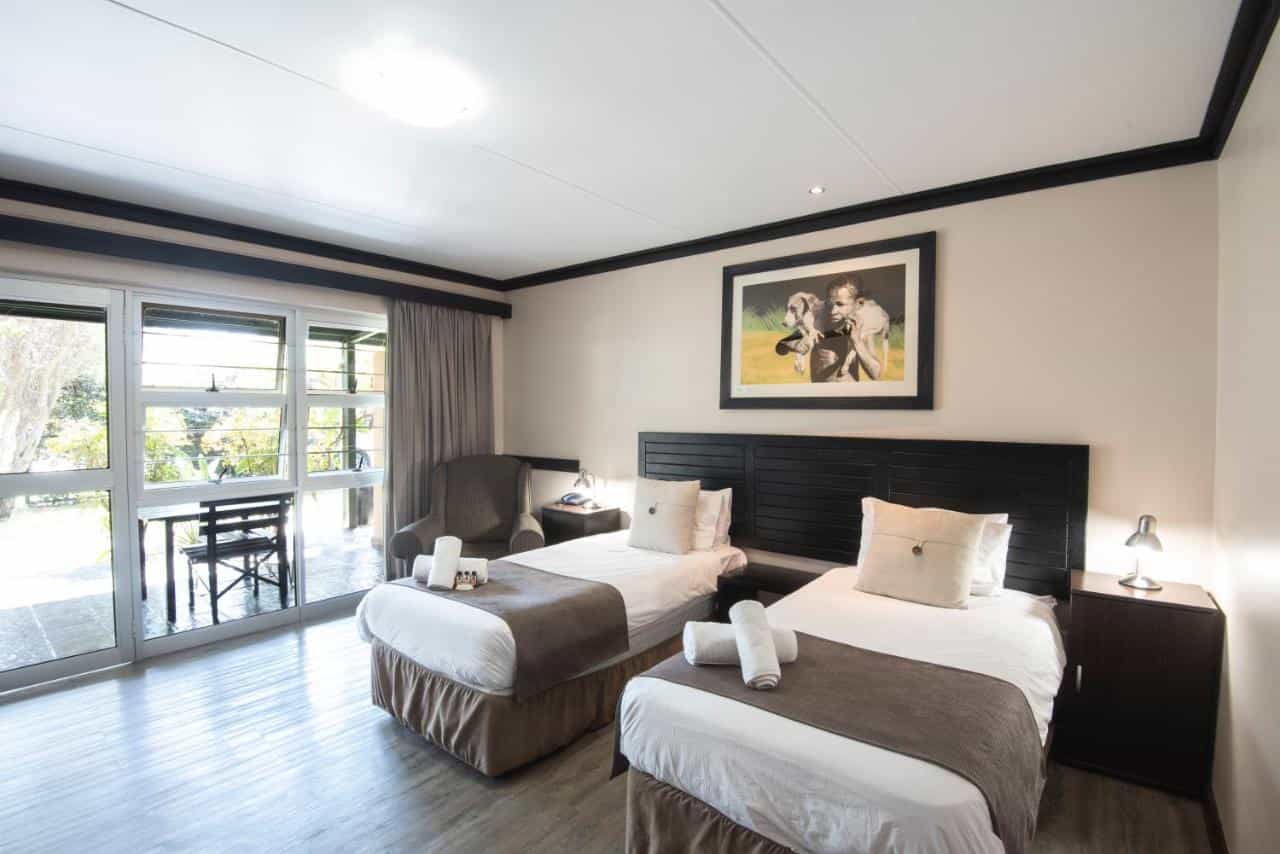
Windhoek
You'll stay in a twin-share en suite room at the Arebbusch Travel Lodge. The hotel is set in large grounds by the dry Arebbusch River with a huge pool outside, making it the perfect spot to relax before the adventure begins.
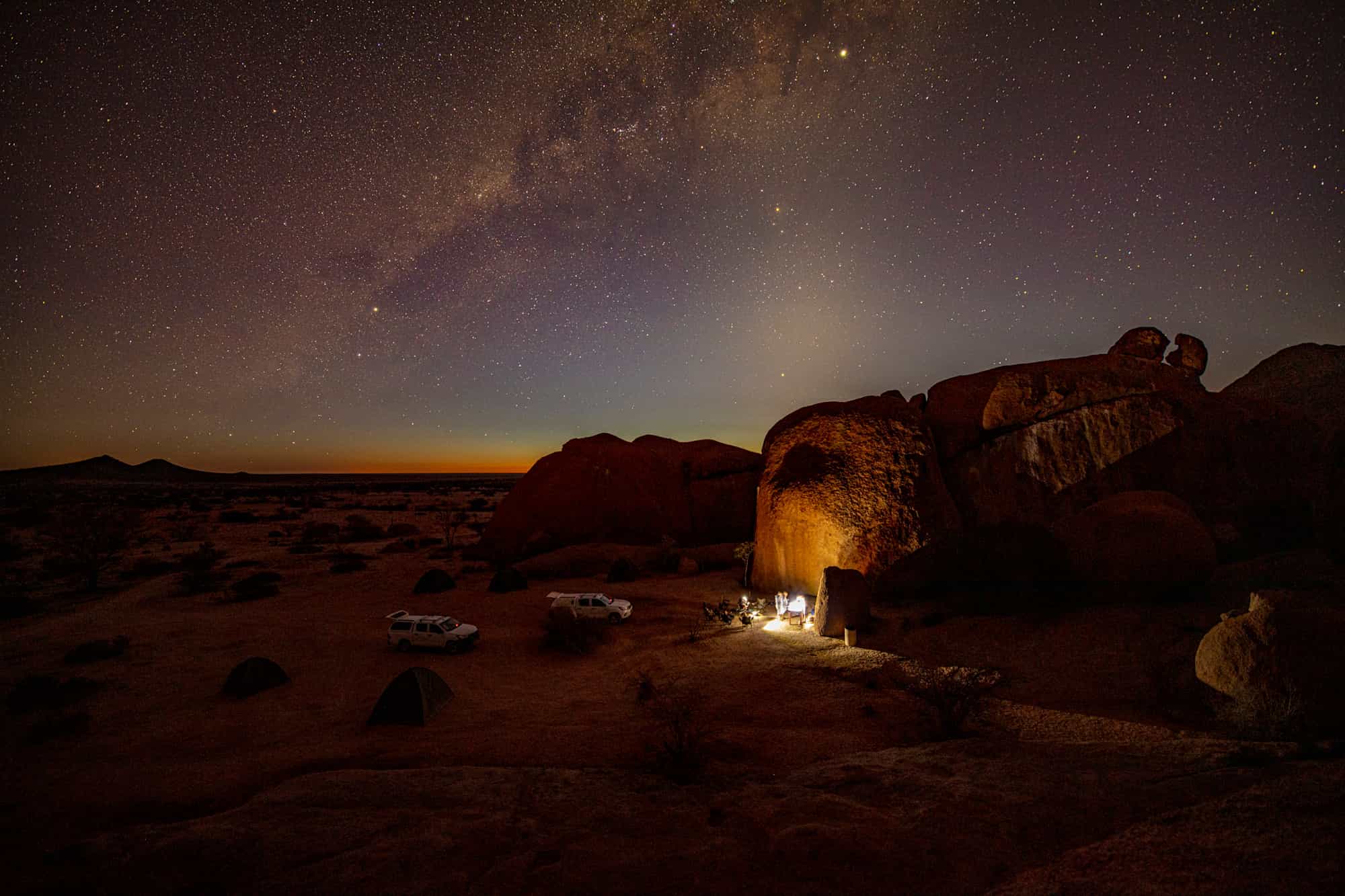
Camping
During the trip, you’ll camp in twin-share tents at a series of desert camping spots in Otjiwa, Spitzkoppe, Sesriem, Solitaire, and Stofpad. These remote locations make for truly memorable experiences, as you'll be camping out in the wilderness beneath some of the starriest skies in the world. At Sesriem, you are surrounded by the highest sand dunes on the planet, while the Spitzkoppe campsite is set amongst a lunar landscape and stunning mountainous backdrop. Facilities include shared bathrooms with hot showers – some basic, others more developed. Each campsite typically offers shaded areas, water basins, BBQs – and in some cases, electricity. Tents and mattresses are provided, but you'll need to bring your own sleeping bag and pillow (check the Kit List). Please be aware, this is a participatory camping trip: so you'll need to pitch in when it comes to putting up and breaking down camp, throughout the trip. It's all part of the adventure!
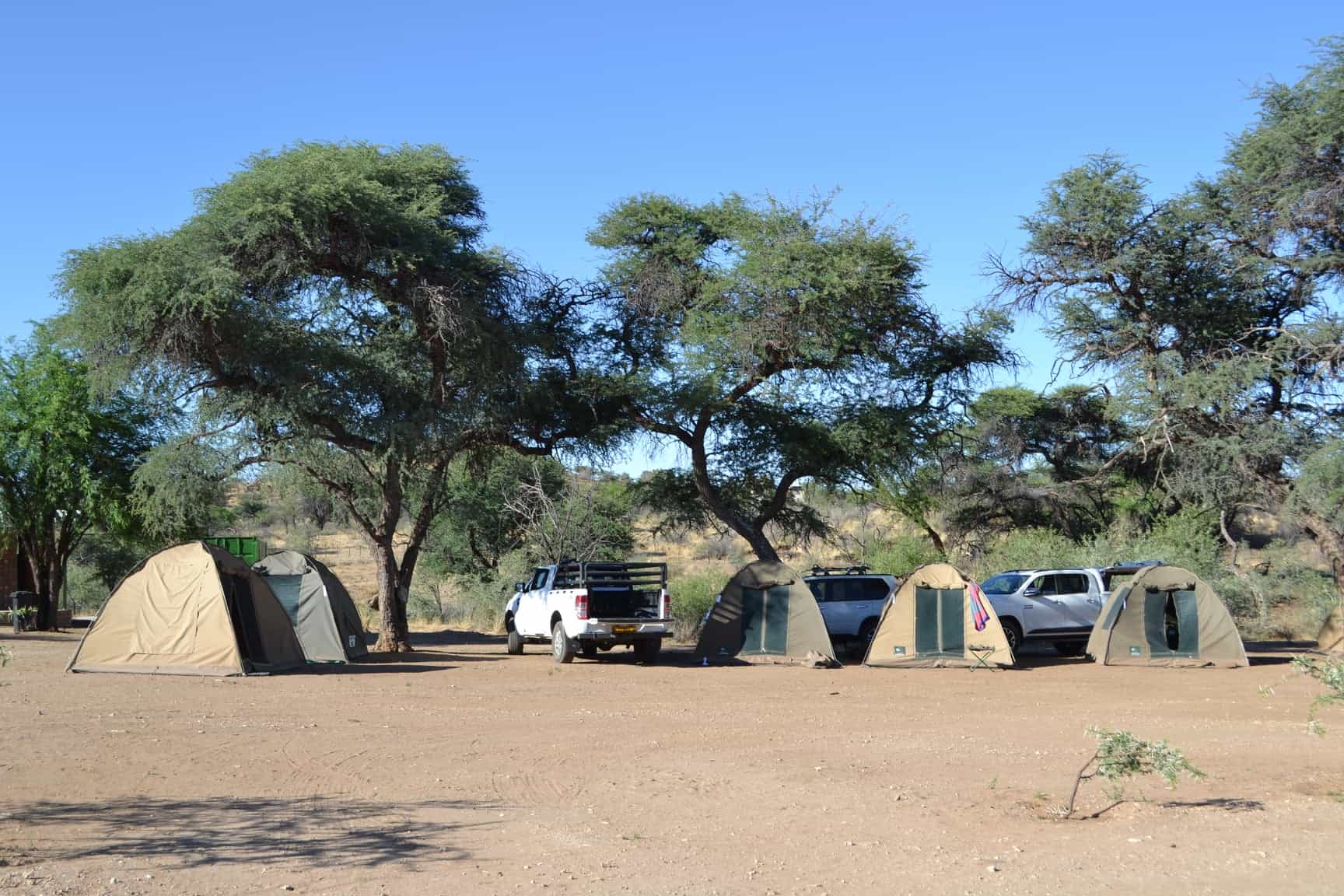
Etosha National Park
You'll spend one night at Okakuejo campground in the heart of Etosha National Park. This spacious site has a restaurant, shop, and a pool to cool off in after hot days. Okakuejo also has a magical waterhole that is floodlit at night, allowing you to watch a cast of characters coming in to drink at night. Staying up late at a waterhole is one of the absolute highlights of a trip to Etosha.
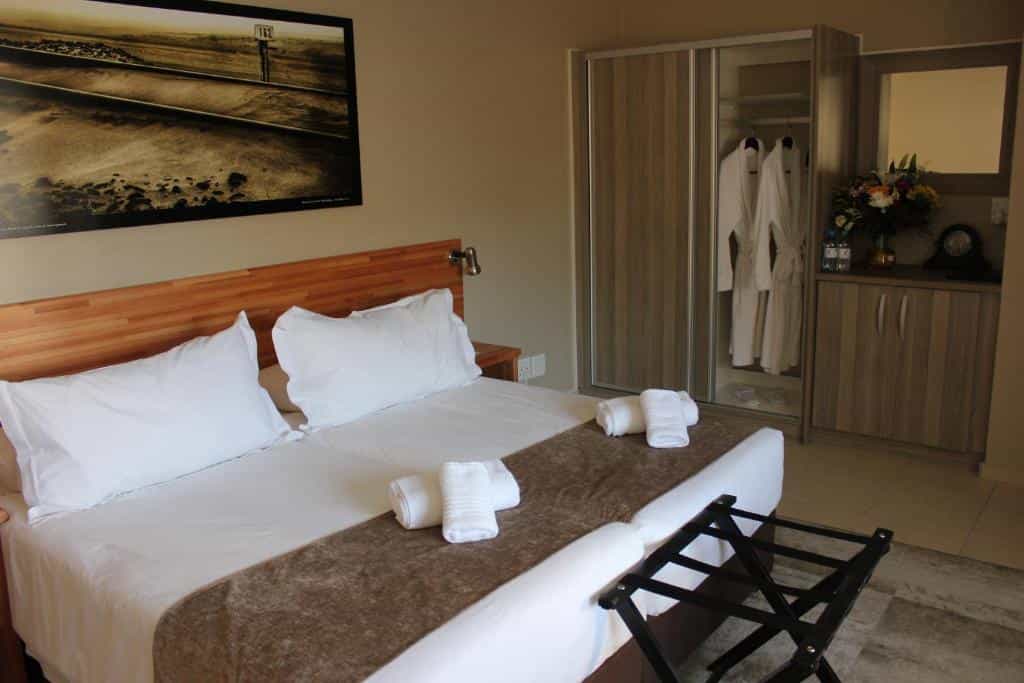
Swakopmund
In Swakopmund, you'll spend two nights in a real bed in a guesthouse to break up the camping. You'll stay in the Prost Hotel or similar – but whichever hotel is selected, it will be in a central location so you can easily explore the town and beach, and you'll share en suite rooms on a twin-share basis.
Upgrades
For solo travellers looking for their own space, an optional private room and tent can be booked for an extra charge, see Optional Extras for the price . Please request this at the time of booking (this is subject to availability).
This trip has been rated as Moderate
This trip is designed for cyclists with a decent base level of fitness who are able to cover an average of approximately 15-30 miles each day. You should be comfortable with riding back-to-back days and with the longer distances and elevations specified in the itinerary. You should also be aware that these can feel more challenging due to the predominantly off-road terrain and the climate. Some preparation rides on uneven terrain, such as gravel and dirt roads, will enhance your overall experience. That being said, no technical skills are needed – just a bit of stamina and a sense of adventure. If the sun gets too intense or your legs need a break, the support vehicle is always nearby to jump in for a bit of respite.
You will be able to cycle at your own pace and your guide may adapt the daily cycling distance from time to time, depending on the group's ability, the weather and local road conditions.
Style of Riding: Mixed Terrain This trip offers a varied riding experience across both paved and unpaved surfaces on a mountain bike. You'll mostly ride on wide gravel tracks and hard-packed dirt paths that can be bumpy or uneven in places. You'll also follow some quiet roads that are largely smooth with the occasional pothole, crack, or rough patch. While the terrain is diverse, it remains non-technical throughout — no singletrack or advanced bike handling skills are required.
Terrain Breakdown: Days 2 & 3: Jeep dirt tracks Days 5, 7 & 8: Gravel open road that can be sandy, bumpy and undulating Day 6: Fat biking on packed sand dunes. This will be on modified (fat) bikes and you can choose which dunes to ride up or down, making it as challenging as you like. Day 9: Asphalt road
Want to sharpen your off-road skills – including handling climbs, descents, and loose terrain? Check out our weekend adventure Intro to Off-Road Riding, in the beautiful Chiltern Hills.
What will I need to carry?
All your lodging is pre-booked, and your luggage is transferred from one point to the next. As everything will be transported by the support vehicle, which you will have access to throughout the day, you can cycle completely unburdened if you wish. We do suggest bringing a small fanny pack for carrying essential items like money, cell phone, sunscreen, and a snack. The van also carries tools and spare bike parts if needed.
Namibia is in the Southern Hemisphere, so essentially has the opposite seasons to North America. Due to the desert climate, it is generally dry and pleasant all year round. The months of June to August remain sunny and warm during the day (68-77°F), but drop down to single figures at night in the desert.
Between September and May it gets warmer, with highs of around 86°F; however, it is always a dry heat and still gets cold at night throughout the year. Rainfall usually occurs between November and March. If it does rain, it is minimal and in short sharp downpours that are quite spectacular in the desert.





Namazing Namibia!
We’ve had a magnificent time in Namibia, surpassed our high expectations. The Namib desert cycling, African wildlife, quirky oasis campsites and huge African starlit skies, were all spectacular. We will be talking about this trip for years, and remembering it fondly forever. Thank you MBA for helping us create beautiful lasting memories.




Namazing Namibia
Pros: Fantastic opportunity to see wide variety of locations and environments in beautiful Namibia. From the sandy deserts to the granite mountain formations to the green bushland full of wildlife, we had wonderful wildlife encounters on many days! Fat biking in sand dunes a very fun experience with good bikes and knowledgeable and patient local guide (Hanjo). Luxury camping experience with our tents put up and down for us, delicious and healthy food from our camp chef MC. The truck was comfortable and always had a good supply of water, snacks and guide books.
Cons: Bikes were poorly maintained, almost no functioning suspension on mine. Gravel roads with ridges of solid gravel made for extremely uncomfortable and potentially unsafe cycling without adequate suspension. The chain on my partner's bike came off nine times in the first two rides (and looked like it had never been cleaned). The bottle holder on his bike also came off, almost causing a fall from the bike. The suspension on his bike completely collapsed into the bike and was not fixed. Infuriating to be collected by the truck before being able to finish the cycling segment of the day. Not much commentary from the guide in the bus while travelling. Restaurants we were sent to had almost always only western-style junk food (burgers, pizza & pasta), poor quality and took a long time (pre-orders for the group would be a good idea). Airport transfers from MBA - paid £112. Shocked at the tiny, old car that collected us at the airport for the long journey to the hotel. Very small, no air con, dog hair all over the back seats, half broken seatbelt. Journey back to the airport after the trip, a small car was sent for four people. Only two of our luggage bags fit in the boot, so it was impossible to take all of us to the airport. Two of us waited half an hour for another car to come (which was then the same one we got on arrival). Price of the trip does not include some non-optional things such as set-menu meal on the final evening, compulsory hotel breakfast the next day (why not at camp?), and final night in the Windhoek hotel (almost all of us needed that).
Thank you for sharing such detailed comments about your recent adventure to Namibia. We are delighted that you found Namibia to be a beautiful country and enjoyed many aspects of the trip, including the wildlife encounters, and the fat biking experience.
However, we are sorry to hear that several parts of the trip fell short of your expectations. As the operations manager responsible for this trip, I want to assure you that your feedback has been thoroughly reviewed with our local host, and we have already taken steps to improve the experience for future travellers.
We understand that the terrain in Namibia can be tough on bikes, making regular maintenance crucial. While our host has confirmed that all bikes are serviced before and after each trip, we recognise that the issues you faced indicate that our usual maintenance standards were not fully upheld during your departure. This has been addressed directly with the local team to ensure these are followed more closely moving forward. Additionally, we would like to confirm that all bikes are replaced when necessary - at least every three years - meaning that all bikes now in use are from 2022 onwards. Spare bikes are also carried on trips to resolve any issues that may arise promptly.
Regarding the airport transfers, we were concerned to learn that the service did not meet our expected standards. We take both safety and comfort very seriously, and our local host has raised these issues with the transfer provider to ensure such occurrences do not happen again. We understand that you have already received a full refund for this service as an apology.
Your feedback about the restaurant choices and meal inclusions has also been noted. We are currently exploring updates for the 2026 season, including possibly incorporating the final dinner and breakfast at camp to provide a more seamless and enjoyable experience.
We value your detailed feedback and appreciate the opportunity to improve. We are confident that the above changes will mean that future customers have the best possible experience. Thank you again for sharing your thoughts, and we hope to welcome you on another Much Better Adventure in the future.
Ruth MBA Operations Team
Amazing Guides and Stars
Really friendly guides and people.
Ones if a life time experience getting to cycle up close to wild animals.
The guidance also shared lots of stories from their culture and it was great to learn about it from them.




Great Adventure & Stunning Country
A brilliant trip and an excellent way to explore Namibia. The cycling was varied and challenging (particularly the terrain and hills on day 7). The first two days on fat tyre bikes was a new experience and a lot of fun. The campsites were all quite different, with a couple of locations a little more basic and the rest with excellent facilities and a little bit of luxury. Be prepared for both cold nights and intense heat! Etosha National Park was stunning and the wildlife incredible. Gabriel and MC made a huge difference to our trip and their support, cooking and insight into their country was really appreciated. It was a pleasure meeting everyone in the group - a fun and adventurous bunch of people!

Wonderful insight into Namibia
Wow! What a super trip. Fantastic insight into Namibia, its people, culture, wildlife and other facets of this wonderful country. The cycling was at times demanding but we were allowed to push ourselves just as far as we felt able. A great group of people and our support team of Gabriel and MC worked from dawn till we put our heads down at the end of the day. Food was varied and delicious and any specific dietary needs were accommodated. My advice is to go do this trip and experience the best this young nation has to offer.
What a fabulous trip. Thoroughly
What a fabulous trip. Thoroughly made by the organisation and the like minded team of adventurous cyclists but more importantly the lead by Gabriel and MC. It was pitched so well, not too hard, not too easy. Strenuous, interesting, educational, thought provoking, fantastic camping sites and wonderful food. Namibia is such a great country to visit, vast, dry, unique, and fascinating history and wildlife. Hats off to Gabriel and MC, good luck for the future, MBA are so lucky to have you.
Great trip. We we well
Great trip. We we well looked after by Gabriel and MC. I can't praise them both enough, they worked so hard to ensure the trip was enjoyable and memorable for us all.




Fantastic trip 👌🏼
My wife and I had an amazing time with Gabe and MC the guides. The campsites were much better than I thought, and the food whipped up by chef MC was lovely. I’d recommend taking an aero press, if your a coffee fan, and I small speaker for tunes in the bus while travelling. Oh, and binoculars for wild life spotting. There are a few extra activities to go at too, we enjoyed some sand boarding in the dune which Gabe helped us book. We can highly recommend this trip, it was a fantastic time with a great group of people 👌🏼








A fabulous and varied taste of Namibia
A well-organised and very enjoyable trip that combined a range of amazing experiences in 8 days. The campsites are fabulous and are a mix of beautiful and remote (Spitzkoppe) and pretty luxurious as two of them are attached to lodges. I found two of the cycling days very challenging, but the truck is always there to scoop you up if needed, and the cycle through the private reserve was absolutely wonderful. Gabriel and MC were brilliant hosts, and the food at the campsites was great. Fat biking in the stunning dunes was an amazing experience, and the wildlife in Etosha was very special. All in all, a great way of exploring part of Namibia and I would highly recommend!
An Arduous Cycling Trip
These are my personal experiences of the trip as a fit and strong 40 year old crossfitter who can ride a bike but isn't a sport specific cyclist.
Pre trip experiences: This was my first MBA trip and the style of putting all trip details on the website seemed helpful but actually the kit list, itinerary and the FAQs were in some or many places not helpful or accurate. E. g. FAQ about water being supplied on trip was not my experience - in country the guides told us to buy 5L bottles from shops as we went round for our own drinking water management. The kit list is generic and high level and needs more detail for the specifics of desert cycling in a hot country. You won't be most comfortable if you stick to the generic kit list on the website. The itinerary for the trip was changed by local operator as they thought it provided a better experience. Of course they asked the group's opinion/consent, but since I had never been to Namibia or cycled a lot how was I to know any better. To be clear I'm not saying it resulted in a problem but just an FYI what you see on the website isn't necessarily exactly what you will do or in that order. And for trips like cycling where cyclists like to know all the distances and timings that can be important to people. Also it didn't make clear that some of the cycling is time bound so if you don't cover the stated distances you will be hoovered up by the support truck before you can complete it, even if you want to complete it. . . i. e. you are involuntarily forced to stop cycling and get on the truck.
Trip experience: This was a cycling trip and the conditions were uncomfortable and arduous on the bike. . . about 90% of the distance (5 days) takes place on dirt sandy gravelly road tracks which significantly slow less experienced cyclists and are quite arduous and at times leave you feeling a bit unstable. To be clear I can ride a bike competently but to handle these confidently you probably need to have done some moutain bike/off road cycling. Generally the terrain is flat but it's still very challenging due to difficult road surfaces. There is about 10% on tarmac roads which is ok.
Most people on this trip were either elite cyclists, or keen cyclists or endurance athletes (e. g. triathletes). Anyone not in the category basically took an e-bike upgrade option and this made their life a LOT easier on the trip. I probably was the slowest as I neither took the e-bike nor is my training modality of crossfit built for endurance like cycling.
Then there are 2 days of desert cycling on fat bikes. Personally I found this very frustrating, it was either a little on the flat and ok otherwise it was on inclines and declines which were just impossible to complete. You just sunk into the sand on the inclines as you slowed. For some this was an exciting challenge, for me it was just annoying and repeatedly futile. The leader of this activity (a 3rd party, not the local operator) was helpful and supportive but at the end of the day you aren't going to become competent in desert sand cycling in the few hours you have and until you become competent it's a bit frustrating. It's very novel and unique which is great and I'm glad I've tried it but I wouldn't be doing it again by choice.
Accommodation wise there is a lot of camping, and it's made as comfortable as possible with large tents and good ground mats supplied. . . however most of the days we camped were in grounds of hotels, and had I known this I would have liked to upgraded to a room (about half the participants on the trip felt the same) but since we weren't aware of the locations and dates specifically until we arrived on site we invariably found the hotels were fully booked. Only on one night did we manage to get a room and I'm glad we did.
The guides were pretty good. I've read some reviews on MBA of this trip praising them to high heaven and I think they were good but don't stand out vs other trips I've been on. At one point someone came off their bike and the support truck and guide were in front of them so it was down to the lagging cyclists to spot this and help out and call the guide. This was poor and should never happen.
I've never done a safari before that was great, we got to see so many animals that I've never seen in the flesh and there being only 2 days of safari is perfect as you actually get a bit complacement when you see your 50th Zebra and that happens within about 36 hours because we see so much wildlife.
There are one or two free afternoons on the trip and I used these to book some activities for myself, e. g. half day city tour of Windhoek and desert quad biking which was great!
Overall the trip allowed me to do a lot of new things in a country I'd never been to before so it ticked a lot of boxes but my non cycling background made it fall short of the enjoyment I hoped it would bring. A few better details from MBA as well would help better preparation too. The aforementioned "being hoovered up by the support vehicle" if you weren't going fast enough was also quite annoying. I went on this trip to complete the challenges I faced, even if it took me a little longer, and being on a holiday where someone else is dictating this is not the freedom I want from a trip I've paid for. If this was to be the case then the guide should say "if you think you are going to be slower, then you can set off an hour earlier". We weren't given this option and it was quite possible to enact since the roads in Namibia are long and without turn off so you can't go wrong (the entire trip there was no guide at the front of the cycling pack and we didn't need to stick in one group, people were stretched out over 20km on some days). Plus most of us bought Namibian sim cards at the airport so had comms.
If you're a die hard cyclist who enjoys off road I think you'll love it but otherwise do ask a lot of questions pre trip to ensure you get the most out of it and are aware of how challenging it might be.
Thanks a lot for your review. As the operations manager who looks after this trip, I have fully reviewed your feedback in conjunction with our local host and have taken the following actions:
We have recently reworded the text around the difficulty level of this trip and have added some further detail to ensure that all customers are adequately prepared for the challenge of the cycling involved.
We have reviewed the kit list alongside our local host (who is a very experienced cyclist) and with a few tweaks, they have now confirmed that they are happy that the list is a fair idea of what each person should bring on the trip without being too specific. We have also made a couple of small amendments to the FAQs.
The rest of the feedback has been carefully studied and will be fully considered when reviewing the trip in the future.
Ruth MBA Operations Team
Namibia Cycling, Safari & Stargazing
I had a fantastic time touring parts of Namibia that would normally be difficult to experience. The guide (Gabriel) was super efficient - and so experienced about every aspect of the tour. Definitely 5 stars!

Life changing trip
Cycle, Safari and Stargaze in Namibia was my first trip with much better adventures and it was amazing. Before, during and after the trip, everyone was so attentive regarding any question or concern. Cycling in namibia gave me a big perspective in life and completitly change me. I had so muh fun and at the same time, relaxing and reflecting moments.


Trip of a lifetime!
This trip was an incredible way to see a fascinating country. From bombing down sand dunes on the fat bikes, to riding alongside White Rhinos and Wildebeest on a reserve, every day brought a new experience.
Most of the cycling was fairly easy, but there were some tougher (but optional) rides like the Grootberg Pass for those that wanted a challenge. All the guides were brilliant throughout the trip, and our group of eight travellers all got along really well. I cannot recommend this trip enough!




As good as I hoped
I'd recommend this trip to anyone looking for some adventure in a far away land. Namibia is a great country to visit full of incredible landscapes, friendly people, good weather and amazing wildlife.
Our guide and driver worked tirelessly to ensure we had a memorable trip, providing lots of local insight, cooking up tasty food and helping us see loads of different sights.
The cycling was as challenging as you wanted it to be, with riding over the dunes a real highlight. I would say the bikes could've been in better condition, but we quickly learnt to make do with what we had.






Challenging but absolutely rewarding trip
The trip was wonderful, the landscapes breathtaking and the accommodation, both hotels and tents, was great. Cycling on sand dunes with a super knowledgeable guide was incredible! The rest of the cycling on mountain bikes on gravel+sand or muddy roads, sometimes with head or side winds, was a bit challenging but that was also part of the fun, making this cycling trip particularly unique. Having the truck following behind was very comforting, though. It was easy to purchase snacks and drinks along the way and to access ATMs (the shopping bags we got from our guide were super helpful!). The cycling safari in a private reserve out of a fabulous lodge was a great way to end this trip. Our guide and driver were excellent too.



Namibian cycle trip
A fantastic trip , the scenery was endless and constantly changing. The accommodation was great especially some of the campgrounds. The guides were so knowledgeable especially re the wildlife and history of the different tribes. The food was always delicious. I would thoroughly recommend this trip.



Namibia cycling, stargazing and safari
The trip was beyond my expectations. Absolutely fantastic! Truly spectacular landscape, stars and guides. Gabriel, MC and Tuffi were fantastic - very informed, great company and MC a fab chef! Lovely fellow travellers. majestic animals- Mother Nature at its very best. This trip is a must. Also included a plane tour to the south, with extraordinary views, plus Gab introduced us to local Tribes women - so fascinating into their history!
Missing the guides already. Just do it!
Namibia is an amazingly beautiful
Namibia is an amazingly beautiful country and you get to see many of its highlights with this tour. You can appreciate the desert flora, fauna and landscapes from both a well-maintained overland vehicle and by bicycle. Our guide, Gabriel, provided cultural and historical context and highlighted the relevance of locations we visited. We were fortunate to have an amazing guide team to support our group which consisted of like-minded enthusiastic and mostly experienced cyclists seeking new adventures. The cycling was easier than I and others had hoped, though admittedly some routes were shorter than billed due to heat and a rain storm. The fat-bike cycling in the dunes at Swakopmund was novel and definitely a highpoint.
I really enjoyed this trip
I really enjoyed this trip but would advise anyone considering it to think about it as an overland tour with some relatively boring (in my view) rough-surface cycling experiences included. Be thoughtful about the time of year you go as well as it will impact what you see in terms of wildlife, seals and stars. That said, the sand dune experience is super and the tour leaders will be grateful if you decide to bring your tourism to Namibia.
A great trip to see the highlights of Namibia.





Gabriel and MC were excellent hosts! Very welcoming, entertaining, knowledgable, and excellent cooks.
We had a couple of really challenging days in the saddle, but plenty of rest time.
Saw loads of wildlife, ate great food, had lovely weather, and an all round good time





A simply incredible trip! I would recommend it to anyone looking to have a real adventure! It was a trip that was fairly out of my comfort zone but I loved every minute! The views, the cycling, the camping, the wildlife, it was all unbelievably fun, beautiful and exciting! One of the best trips of my life!




This trip exceeded my expectations in every way. Namibia has so much to offer, every day was different, the truck was fabulous to travel in, tents are roomy, we enjoyed MCs great cooking morning noon and night. The night sky is phenomenal, I loved seeing the southern cross and the Milky Way so clearly and watching satellites speeding across the night sky in every direction. The campsites are stunning, enjoyed pools at two locations. Etosha didn’t dissappoint and the next 2 days of cycle safari were great fun.


Wonderful country, well organized trip and much fun cycling and exploring with nice group and staff



A really incredible experience! Thanks to Sven and McCloud for being fantastic hosts and sharing with us the amazing Namibian landscape, cycling routes and wildlife. Really appreciated the flexibility in cycling according to how you felt, the great campsites and meals and the group spirit as we explored this great country. Highly recommended!

Superb trip from start to finish! The sand dunes were a real highlight!
This trip is not just about cycling - the like-minded group, the knowledgeable Host, the AMAZING chef, comfortable bus and tents and landscapes and stars, smells, sights and people - all came together to make this such a memorable trip! Highly recommend this tour and definitely wont be the last time I will be visiting Namibia!
Incredible trip. The guides were top notch and planned a great balance of activities and cycling. Hard to pick a favorite thing as each day had several unbelievable experiences. The cycling could be challenging but there’s always a chance to drop out and ride in the truck if you aren’t feeling the challenge that day. It’s a great way to see the country. My group was also fantastic and we got along quite well!

Just sitting down and digesting what was an unforgettable trip to Namibia.
The friendliness and skills of the local guides, fellow travellers, and people of Namibia made what was an already great adventure amazing.
The experience of riding through the desert areas and tracking rhino on mountain bikes will stay with me for the rest of my life. I am pretty sure I will return to this amazing country.





Overall a fantastic, well-organised trip with an incredible variety of landscapes and scenery. Fat-biking on the sand-dunes and camping beneath Spitzkoppe were particular highlights. Would definitely recommend this trip!
Itinerary Activities
- Guided sunset ride through Otjiwa
- Guided ride out of Otjiwa
- Afternoon & morning game drives in Etosha National Park
- Guided ride to the Goanikontes Oasis and on to Spitzkoppe
- Guided ride into the Namib dunes and along the coast (on fat bikes)
- Guided ride through the desert to Solitaire
- Guided ride from Solitaire to Sesriem
- Sunrise hike up Dune 40
- Guided ride between the Sossusvlei dunes
Guides
- Expert, local, English-speaking guides and bike mechanic
Lodging
- 1 night in a relaxing hotel in Windhoek
- 2 nights in a centrally located hotel in Swakopmund
- 6 nights desert camping in spectacular locations
Meals
- All (9) continental-style breakfasts, to fuel you up each day
- 3 picnic lunches
- 3 braai-style dinners, cooked for you over the campfire
- Snacks while biking
Transfers
- Group arrival transfer from Windhoek Airport on Day 1
- Group departure transfer to Windhoek Airport on Day 9
- All transfers during the trip
Support Vehicle
- To hop into if your legs need a break
Luggage Transfer
- A desert truck to carry all your overnight gear
Gear
- Silverback & GT 29ers hardtail mountain bikes
- Tents and sleeping mats for camping
Permits
- All permits and park entry fees
Our trips are hassle-free by design. We include all the activities and equipment, as well as many of the meals, so you can simply rock up with your rucksack and share the adventure with your new pals.
Travel to and from the trip
Our trips do not include flights, trains, or other travel to the start point and back from the end point.
Tips
Tips are not included in the trip cost. These are entirely at your discretion, but there is an expectation to tip for good service. Your host can help with advice; however, we would suggest $6 per person, per day as a guideline.
Of course, you are free to tip more or less, and the amount should be reflective of your perception of service and quality – a tip is not compulsory and should only be given when you receive excellent service.
Personal Expenses
You know your own spending habits best, so please budget an appropriate amount for things like optional meals and drinks, shopping, optional activities, and laundry.
Travel insurance
Travel insurance is compulsory for all of our adventures, and you'll need to provide your policy details before departure. Your insurance should offer adequate cover for overseas medical treatment, evacuation/repatriation, your baggage and equipment, and the specific activities involved in your adventure. We also recommend ensuring your policy includes cancellation and curtailment cover, in case you're unable to join your trip due to unforeseen circumstances such as illness.
Standard travel insurance may not cover all the activities included in your adventure, so it's essential to check the details carefully. There are adventure-specific providers that many travelers have used in the past, such as True Traveller (for those based in the UK or Europe), or Rise + Shield, both of which offer cover for a wide range of adventurous activities.
Please make sure your chosen policy meets your individual needs and covers all aspects of your trip.
Visas
US citizens, UK citizens, and most EU citizens will need a visa to visit Namibia. This can generally be done on arrival, and costs 1,600 Namibian Dollars for citizens from non-African countries. As the system is relatively new, we would advise applying in advance to ensure a smooth process on arrival. For more information and to apply for the visa, please visit the website for Namibia's Ministry of Home Affairs, Immigration, Safety and Security.
However, visa requirements often change, and you are responsible for obtaining any required visas for this trip. Please check with your nearest embassy or consulate for up-to-date advice.
What do I need to bring?
Included
- Camping mattress
Sleeping
- Sleeping bag (3- or 4-season if travelling May-September; at other times of year, a 2-season is fine). Please check the Optional Extras if you'd prefer to hire sleeping bag and pillow from your host.
- Lightweight packable travel pillow
- Sleeping bag liner and pillow case (optional)
Cycling Kit
- Helmet (required)
- Biking shoes (bring your own pedals if using cleats)
- Saddle, if you would rather use your own
- Gel saddle cover (optional if preferred)
- Fanny pack or small handlebar bag for riding
- Reusable water bottles. It is recommended that you bring biking water bottles that fit into standard bottle cages on bikes (17oz, 20oz, or 25oz).
Clothes
- Padded biking shorts
- Loose over-shorts
- Breathable sports tops or biking jerseys
- Biking gloves
- Fleece jacket or similar jacket for the evenings
- Warm base layers
- Light waterproof/windproof jacket
- Buff or neck scarf (it can get dusty on the tracks)
- Pants/leggings for the evenings
- T-shirts
- Underwear and socks
- Sunglasses and sunhat
- Sleepwear
- Sandals
- May-September: down jacket and gloves (it can get cool at night in the desert)
Other
- Duffel bag, backpack or soft suitcase (max. 80L)
- Swimwear
- Quick-dry travel towel
- Padlock for left luggage
- Universal travel adapter
- Power bank or solar charger
- Headlamp or flashlight
- Passports (and visas)
- Travel insurance documents
- Earplugs
- Insect repellent
- Sunscreen
- Binoculars (optional - for wildlife spotting in Etosha)
- Personal first-aid kit (including blister treatment and rehydration sachets)
- Personal items (biodegradable toiletries, sanitary wear etc.)
- Alcohol hand-gel
- Reusable water bottle
- Energy bars and snacks
Full Suspension Bike Upgrade
Payable Before Departure
Full Suspension Bike Upgrade
… Per person
Sleeping bag and pillow hire
Payable Before Departure
Sleeping bag and pillow hire
… Per person
Single Room - Windhoek (Arrebusch Travel Lodge)
Payable Before Departure
Single Room - Windhoek (Arrebusch Travel Lodge)
…
Twin/Double Room - Windhoek (Arrebusch Travel Lodge)
Payable Before Departure
Twin/Double Room - Windhoek (Arrebusch Travel Lodge)
…
Optional Private Room & Tent Upgrade
Payable Before Departure
Optional Private Room & Tent Upgrade
…
Private Airport Transfer
Payable Before Departure
Private Airport Transfer
…
We partner with the World Land Trust to ensure this trip achieves Net-Zero emissions. We also support their Buy an Acre program, helping local communities to buy and protect natural habitats in perpetuity.
What's the number?
It works out on average at 324kg of CO2 emissions per person, including all local transport, accommodation, food, activities, guides, staff and office operations.
The only thing it doesn’t include right now is flights and travel to the destination. We do make an overall estimate across all our customers separately, but as we don’t book flights, have customers from all corners of the world, and no way of reliably knowing their travel plans, we simply can’t include an individual number in the figure on display here. We’ve got a goal to fix that, so that when you book, there is a way to measure and mitigate the carbon emitted by your flight too.
But what does the number mean?
Yep, hard to picture eh? To give you an idea:
- Driving 1000 miles/1609km would be approximately 281kg of CO2 in an average car (or 140.5kg per person, if there were two of you in it).
- A return economy class flight between London and New York would be approximately 1619kg (1.66 tonnes) per person.
- 10 trees in a temperate forest are estimated to remove approximately 250kg of CO2 from the air in a period of 5-10 years.
What are we doing about it?
Our trips are relatively low-carbon by design, and we're working with all our hosts to develop long term carbon reduction plans. We partner with the World Land Trust to ensure this trip achieves Net-Zero emissions. We also support their Buy an Acre programme, helping local communities to buy and protect natural habitats in perpetuity, ensuring the protection of the reserve and its wildlife.
Want to know more?
Amazingly, no international travel company has ever publicly published their carbon measurements before, as far as we know. We believe that must change, quickly. So we’re openly sharing the method we used in the hope that other companies will be able to more easily follow suit and build on what we've done so far. You'll find it all here.
It's no secret that we love cycling and many of us at HQ think it's the best way to see a country; however, we realize that organizing your own trip can be a total hassle. On our cycling trips, we've found a local guide who has put together a perfect route and will navigate for you all the way. We even send a van that transports your overnight luggage and provide high-quality bikes and delicious snacks to keep you going. Hassle eliminated! All you have to do is show up, pedal, and take in the landscape with your fellow cyclists. You don't need to be a lycra-clad 'roadie' although they're welcome too!
For the majority of the trip, you will typically be riding Silverbacks or GT 29ers – hardtail, entry-level mountain bikes. These are light aluminum mountain bikes – perfect for riding on road and tracks. The bikes are equipped with two water bottle cages. You are also welcome to bring your own bike, but do make sure it's well serviced and please note, it will need to have tubeless tires.
For your time on the sand dunes, you will be provided with a fat bike. Fat bikes are mountain bikes fitted with extra-large tires, which makes them perfect for riding on sand. The super fat tires distribute the rider’s mass across a larger area, so that you don't sink in and can gain more traction than with a standard tire size. You can ride easily and with stability over firm packed sand. No previous experience on a fat bike is needed.
For a more comfortable ride, you can rent a full-suspension mountain bike locally (S-Works/Specialized). Please see the 'Optional Extras' section for more details.
In Etosha, your host uses the main trip vehicle for the game drives, which we feel offers the best experience and value for money. This main trip vehicle is specially adapted to offer excellent wildlife viewing opportunities, with large windows and a pop-up roof hatch. In addition, these vehicles also provide shelter from the dust and elements, which can be uncomfortable in open Jeeps during particularly dry periods in Etosha.
For those who wish to have a different experience, there is also sometimes the option to go on a game drive in an open 4x4 Jeep with a park ranger (if time allows). This option is bookable locally and costs 1,600 Namibian Dollars (around $85 per person).
Yes, you can try to book last minute, but if you are requesting a spot less than 31 days in advance, the host will need to check accommodation availability before accepting your booking. The lodges we use on this trip are extremely popular and space is limited, so bookings requested less than 31 days prior to the trip can be hard to confirm. We therefore definitely recommend booking early to guarantee your spot on the trip.
There will be one driver and one biking guide.
All your accommodation is pre-booked, and your luggage is transferred from one point to the next. As everything will be transported by the support vehicle, which you will have access to throughout the day, you can ride completely unburdened if you wish to. We do suggest bringing a small fanny pack for carrying essential items like money, cell phone, sunscreen, and a snack. The van also carries tools and spare bike parts if needed.
E-bike upgrades are not available for this trip; you’ll be riding hybrid bikes as listed in the trip inclusions. We do, however, have a growing collection of e-bike adventures which you can explore.
Your host will often be able to provide you with clean, safe drinking water from large containers. At certain times of the year, the tap water can have a slightly strange (brackish) taste to it, and on these trips, the guide will advise and help you to pick up containers of drinking water at the start of the trip to refill your smaller bottle as you go. This will be at your own expense. Therefore, bring a refillable bottle, it will be used well.
In the event of poor weather such as heavy rain, strong winds, and/or storms, it is possible that conditions may become unsafe to complete the planned rides on this trip. Your guide will assess the conditions and weather forecasts and make a decision with your safety in mind. If it becomes necessary to make a change to the planned itinerary, an alternative route or activity will be offered.
Most places in Namibia will accept both the Namibian Dollar and the South African Rand. Money can be exchanged on arrival at the airport or withdrawn from ATMs during the trip. Many local purchases can be made by card. Plan ahead before you travel to avoid paying unnecessary charges and fees.
This trip operates in areas where daytime temperatures can reach extreme levels, with limited shade and, at times, high humidity adding to the challenge. These conditions can affect physical performance and increase the risk of dehydration or heat-related illness. Your guide will adjust the pace and monitor the group closely, but staying well hydrated, wearing suitable clothing, and using sun protection is essential.
Before traveling, consider your ability to remain active in high temperatures and consult a medical professional if you have any concerns, especially if you have cardiovascular or heat-sensitive conditions. Arriving a day or two before the trip may help you adjust gradually to the heat.
This trip takes place in environments where wild animals are present in their natural habitat, where protections and controls on their movement may be limited or non-existent. Some species may be dangerous, venomous, or unpredictable. Sightings are a privilege, but safety is key. Always follow your guide’s instructions and any posted signage.
We recommend considering your comfort around wildlife and discussing any concerns with your host before travel, particularly if you have allergies, phobias, or related health conditions.
Sure can! Over 70% of our travellers travel solo, it’s a great way to meet like-minded people.
Our team of Adventure Hunters co-create exclusive adventures which are run by highly vetted, specialist hosts. The trip is run by our trusted host partner in the destination. We only work with independent, local, in-destination experts who know the very best places to explore and how to stay safe. Read more information about the local teams we partner with. You’ll be introduced to the host straight after making a booking via the Much Better Adventures platform.
Much Better Adventures refer to the UK Government’s official travel advice when designing trips and monitoring trip operations. We recommend that all customers review the practical information available on the UK Government’s FCDO website, where you can find up-to-date advice by searching for your destination(s).
If you are based in the United States, you can also check the latest travel advisories from the U.S. Department of State.
For customers joining from other international locations, we recommend checking the official travel advice issued by your country of residence, as guidance may vary.
We recommend checking out the country-specific information and also talking to a travel nurse.
We automatically convert prices from the local currency that a host receives to your chosen currency. We update our exchange rates daily, so prices displayed on the site are subject to currency fluctuations, which is why you may see them change over time.
If you wish to change the currency you pay in, head to the bottom of the page.
All of our group adventures are specially designed for adults to enjoy as we want these adventures to bring together outdoorsy people who are truly like-minded. You must be over 18 to join one of our trips.
You're always in good company on one of our adventures.
Our trips typically consist of a mix of solo travelers and small groups of 2 or 3 friends, with most in their 30s-50s.
Our sociable adventures are solo-friendly by design and naturally attract outdoorsy people with a shared mindset; a love for adventure, a desire to push themselves, and meet awesome, like-minded people along the way.
It’s this camaraderie that has so often turned a great adventure into a life-changing one.
Don't just take our word for it:
- 95% of people rate the group dynamics on our trips 5/5
- 90% of people recommend joining a trip to make new friends
- 75% of people have met people on our trips that they would now consider friends
See here for more info about the Much Better Adventures tribe.
Reviews

Namazing Namibia!
Debra S. April 2025

Namazing Namibia
Emily C. January 2025

Great Adventure & Stunning Country
Robert G. December 2024

Wonderful insight into Namibia
Michael H. December 2024

Fantastic trip 👌🏼
Stephen B. November 2024

A fabulous and varied taste of Namibia
Caroline B. October 2024

Life changing trip
Maria á. July 2024

Trip of a lifetime!
Miss C. July 2024

As good as I hoped
Tristan E. July 2024
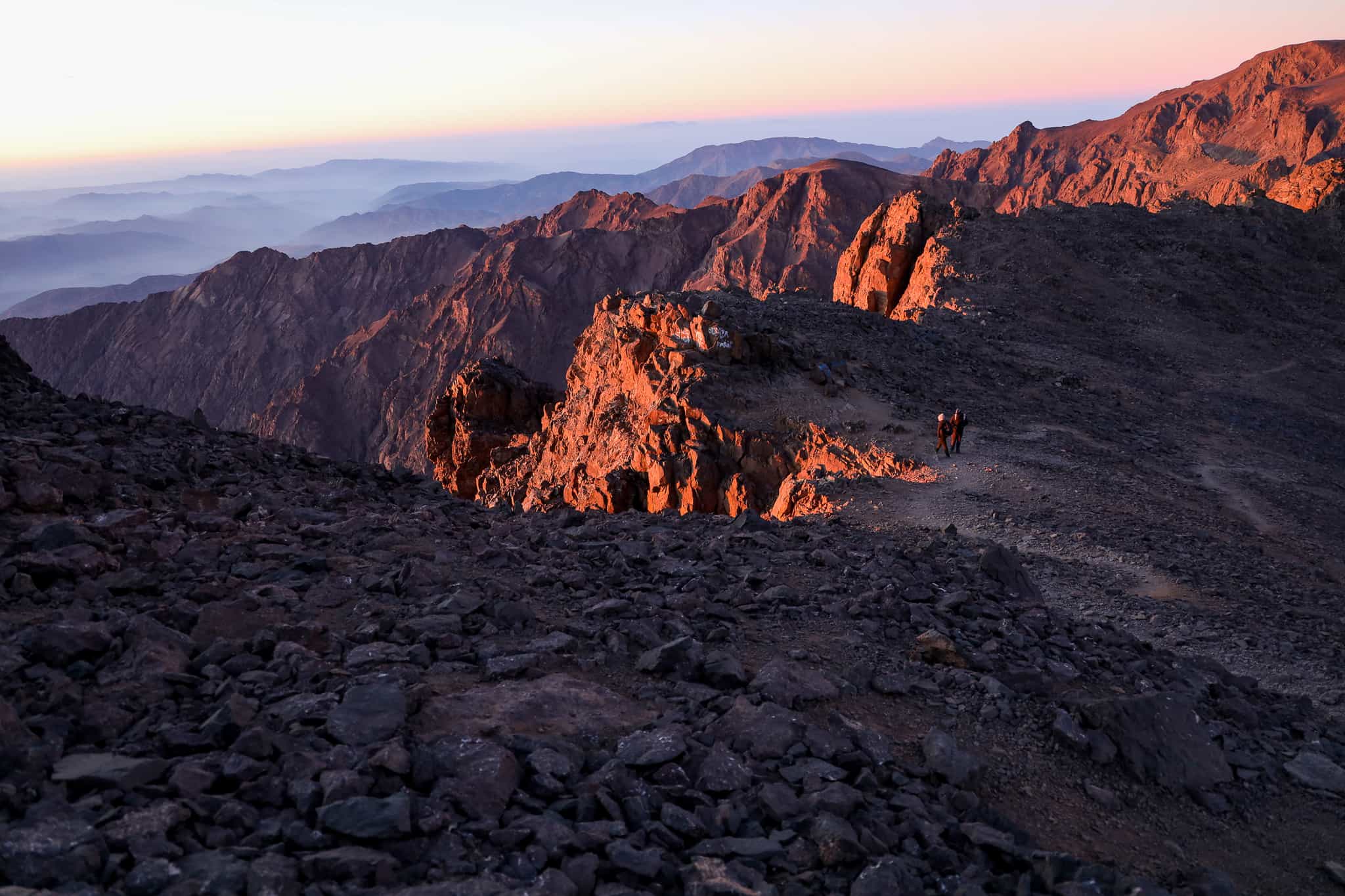
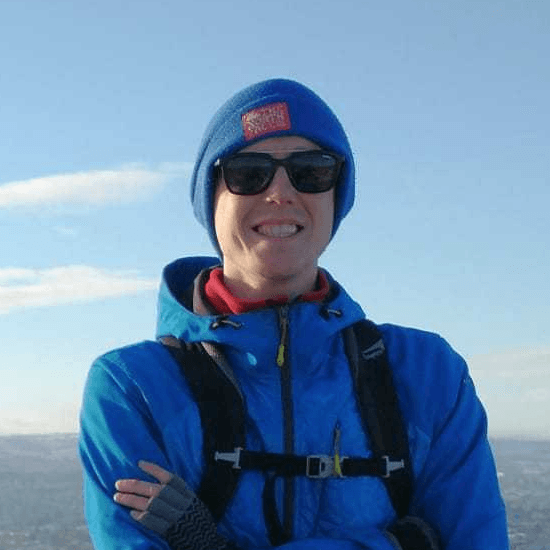
How fit do you need to be?
Every trip is different. Our friendly experts are here to help, whether it's about altitude, terrain, or recovering from injury.
We've got your back
Guaranteed to run
All Much Better Adventures trips are guaranteed to run. Once you’ve booked your spot you can immediately make your travel arrangements, no uncertainty, no hanging about (excludes 'request to book' departures). Full details
Flexible payments
Secure your spot with the minimum deposit and pay off the remaining balance in as many installments as you like, with no interest or fees. Full details
Happiness Guarantee
We’re so confident you’ll have an amazing time we’ll put our money on it. Full details
Full financial protection
For total peace of mind, Much Better Adventures is backed by ABTOT and ASTA memberships. Full details
Tried & Trusted
Much Better Adventures is consistently rated ‘Excellent’ on Trustpilot, with over 1000 verified trip reviews.
Connect before you go
You'll be invited to join a WhatsApp group to get to know each other before your big adventure together. Full details
DEPARTURE DATES
Friday 1st May 2026
to Sunday 10th May 2026
2026 Early Bird Sale Offer - Next 1 spot available at 10% off




